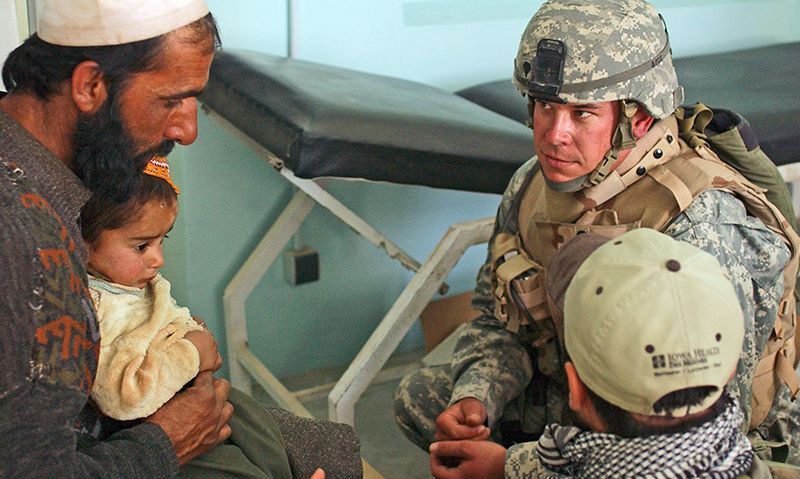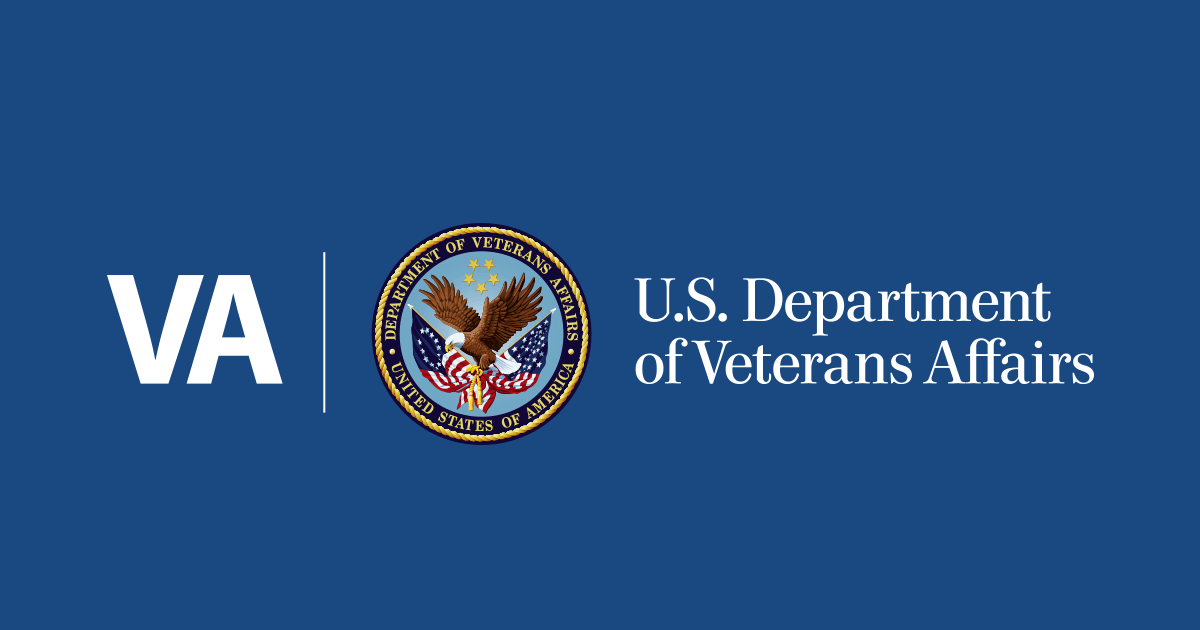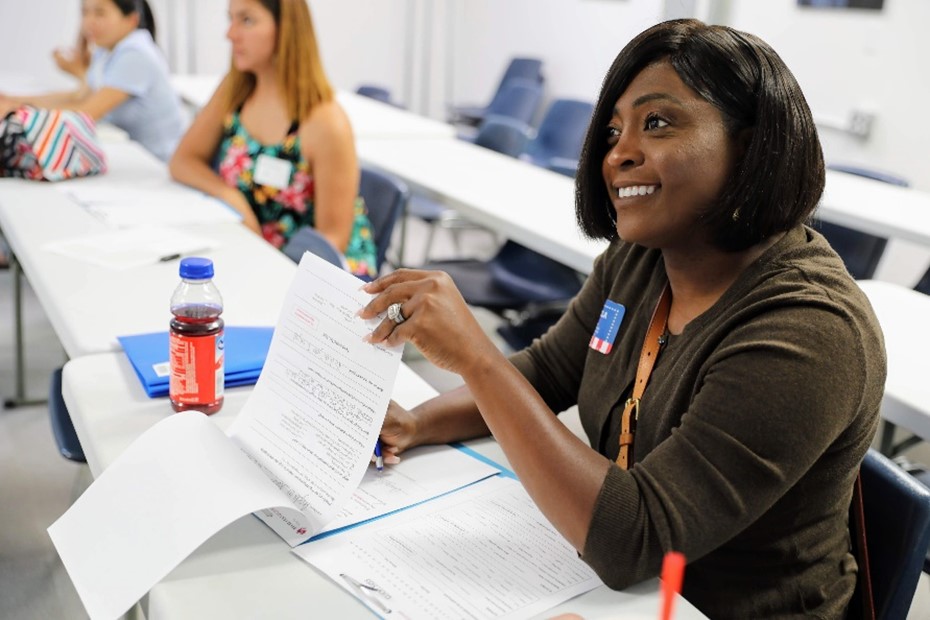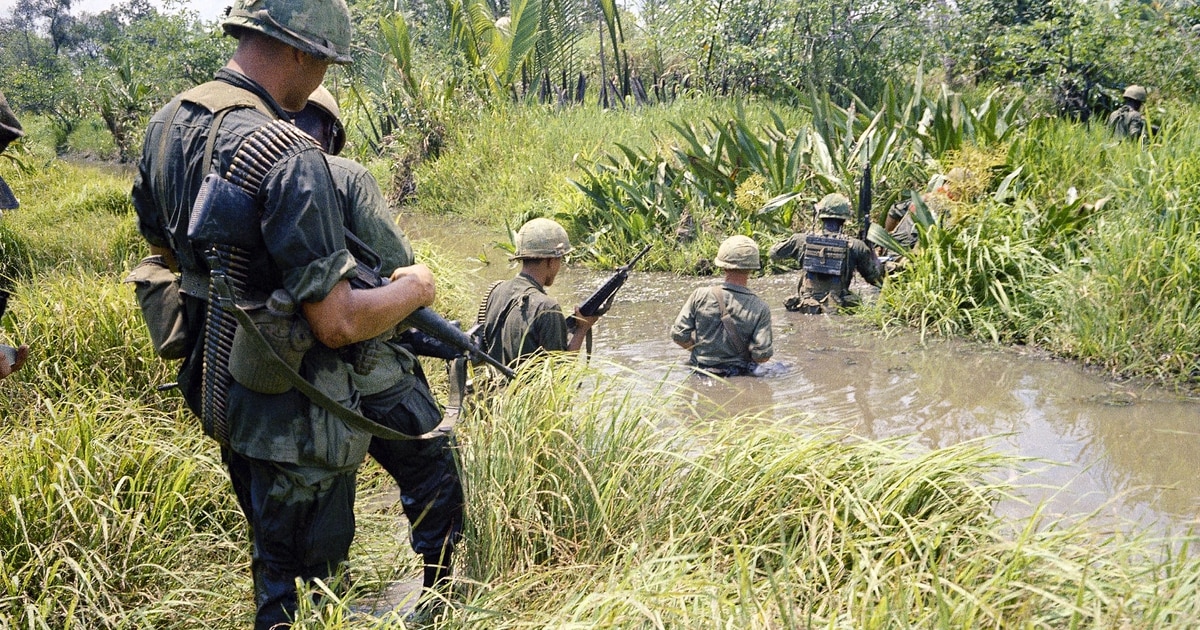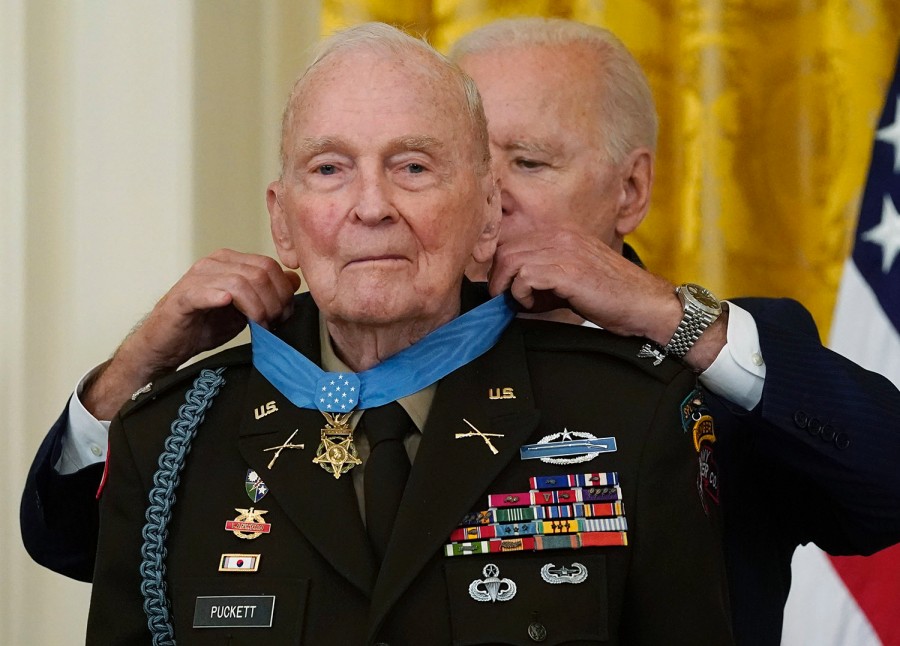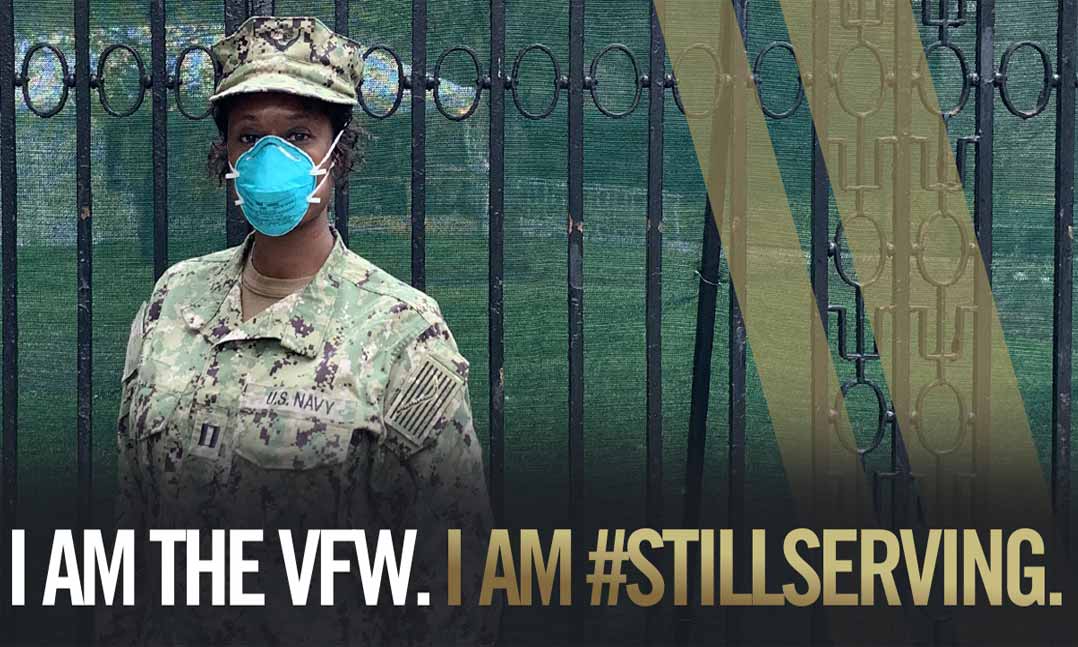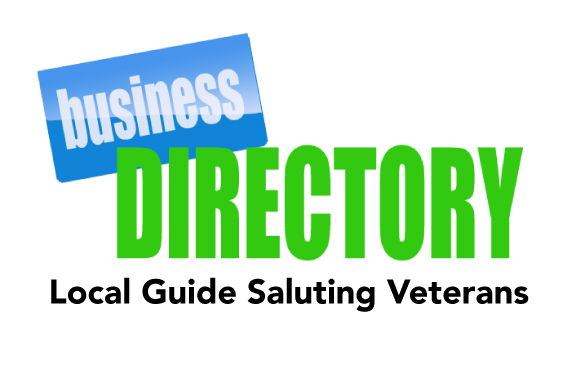News
By Mackenzie Wolf
American Legion National Commander James W. “Bill” Oxford expressed “deep disappointment” the White House isn’t offering a better plan to evacuate interpreters, family members and other Afghan allies who have served alongside U.S. forces during the last 20 years of war in Afghanistan.
The White House announced on Thursday the United States’ military mission in Afghanistan will conclude on Aug. 31, putting the end to a “forever war” in sight. However, that does not go far enough to protect the 18,000 Afghan interpreters who are still waiting for approval of their Special Immigrants Visas — a promise the U.S. made to them in return for their service.
Earlier, the White House said they would house the interpreters and others in a third country pending their visa approval. The American Legion does not believe this action will ensure the safety of all the Afghanistan allies, due to the number and time remaining before the pullout.
There is a precedent of such a mass evacuation that the U.S. could emulate in this scenario.
In 1975, the United States evacuated about 130,000 Vietnamese refugees after the fall of Saigon. Most refugees were held temporarily in Guam before going to the U.S. as their visas were processed. More recently, in 1996, the U.S. evacuated thousands of Kurds at the end of the Iraqi Kurdish Civil War, with a stopover in Guam.
Calling the Taliban “the enemy of all human rights,” and welcoming an end to U.S. involvement in 20 years of conflict in Afghanistan, Oxford said the withdrawal must be conducted in an honorable and orderly manner and that the current pace of withdrawal is falling short on these counts.
“Abandonment of those who assisted us is literally an issue of life or death,” Oxford said. “Any veteran who has worked with Afghan interpreters will tell you how valuable these brave heroes were to our mission there.”
Their service alongside American forces has made them — along with their families — targets for retribution by the Taliban as the militant group gains ground across Afghanistan.
“It is a moral imperative that we offer them immediate and safe passage away from the enemy and to the United States,” Oxford added. “If we abandon such friends, how could we expect any assistance by potential allies in future missions?”
WASHINGTON — The Department of Veterans Affairs awarded $418 million in grants to more than 260 non-profit organizations in June, allowing low-income Veteran families around the nation to access services under the Supportive Services for Veteran Families program.
SSVF grantees are authorized to use the funds to rapidly re-house Veterans who become homeless or to prevent Veterans from becoming homeless.
“As a result of VA’s Supportive Services for Veteran Families program and other housing assistance efforts, Veteran homelessness has been cut in half since the launch of 2010’s Federal Strategic Plan to Prevent and End Homelessness,” said VA Secretary Denis McDonough. “Since then, hundreds of thousands of Veterans and their families have been placed into permanent housing or prevented from falling into homelessness by VA’s homelessness programs and targeted housing vouchers provided by the Department of Housing and Urban Development.”
SSVF grantees are in all 50 states, the District of Columbia, Guam, Puerto Rico and the U.S. Virgin Islands. Through partnerships with VA and community programs, SSVF provides eligible Veteran families with outreach, case management and assistance obtaining VA and other benefits, which can include health care, financial planning, childcare, legal and fiduciary payee assistance, transportation, housing counseling and other services.
Helping Veterans in need of permanent housing remains a critical priority for VA. In fiscal year 2020, VA served 112,070 participants, including 77,590 Veterans and 19,919 children through the SSVF program.
This year’s grant recipients successfully competed under a Notice of Fund Availability published November 19, 2020. The funding will support SSVF services from October 1, 2021 through September 30, 2022.
Learn more about the SSVF program.
(VAntage Point)
Transitioning from active duty to the private sector is jarring for many Veterans. As many as 27% of Veterans struggle with adjusting to civilian life according to the Pew Research Center. This can be particularly difficult for female Veterans, but VA and other private sector organizations are stepping up to support these women. One organization, Dress For Success Austin (DFSA), provides a network of professional support, business attire and development tools to help all women thrive in work and life.
DFSA and its affiliates across the country have three programs for any woman who would like career development assistance:
Suiting – work with women to choose an interview outfit and provide guidance and support for the upcoming interview.
Career Advancement – support and assist women in identifying and striving towards their professional and personal goals. Includes mapping out the future through financial planning.
Leadership Training – teach women to advance their careers and give back to their communities.
One former Veteran, Jessica Kirkham, recently landed a job at TikTok using Dress for Success resources, a career change after working for a combined five years as a cryptologic linguist in the Navy and for the NSA.
“I was led to DFSA while attending a Veteran Transition seminar hosted by the Texas Veterans Commission,” Kirkham said. “I was looking for guidance on translating my military experience into something civilian recruiters and hiring managers would understand, and DFSA’s Bridge the Gap for Women Veterans program helped me do exactly that. They also set me up with my mentor, Summer McAfee, and she helped steer me in the right direction with numerous phone calls and Zoom sessions, through which we polished and perfected my resume and interviewing skills.
“With support from organizations like Dress for Success, people of all ages and stages can build the confidence and soft skills they need to land their dream job,” she added. “Veterans bring strong leadership skills, discipline and other critical competencies to companies in the private sector. Dress for Success Austin and BreakLine (a nonprofit in San Francisco) helped build my confidence and readiness to bring my authentic self to the private sector, specifically to TikTok.”
If you or someone you know is interested or would benefit from working with DFSA or any of its affiliates, you can find their contact information at: https://austin.dressforsuccess.org/contact/.
DFSA exclusively supports women, but there are other organizations like Career Gear that provide similar services for men actively seeking employment. They can be contacted at: info@careergear.org.
To see more information like this, subscribe to VetResources, visit: https://www.va.gov/vetresources/.
Social Media:
Dress for Success Austin
Facebook: @DFSAustin
Instagram: @dressforsuccessATX
Twitter: @DFSAustinTX
YouTube
Dress for Success Worldwide:
Facebook: @DressForSuccess
Twitter: @dressforsuccess
Instagram: @dressforsuccess
YouTube
LinkedIn: @dress-for-success-worldwide
The sharing of any non-VA information does not constitute an endorsement of products and services on the part of VA.
Ian Lacy is a communications specialist in VA’s Veterans Experience Office.
As Americans are managing life with the Coronavirus and now with the vaccine finally rolling out, and mask mandates lifting for the fully vaccinated, the travel industry is continuing to come back. Hotels and travel destinations in many parts of the country are open in anticipation of travelers ready to throw off their cabin fever and venture out.
Your plans may be for a weekend get away to a cozy bed and breakfast, or perhaps a fishing trip to catch that “big one” that won’t get away this time. Maybe it’s a camping trip full of hiking adventures with stunning vistas, or possibly you would rather walk through America’s glorious past by taking in all the amenities offered in any of hundreds of museums. How about a week’s stay at a ranch out west? Whatever your travel desires are, your options are plentiful and, more importantly, clean, safe and following all CDC guidelines for Coronavirus.
Each week we will list state by state travel options we recommend to help make your vacation choices easy.
ALASKA:
Kenai Magic Lodge – Anchorage.
MD Discovery Alaskan Charters – Ketchikan.
ARIZONA:
Stampede RV and Bed & Breakfast – Tombstone.
Hall of Flame Fire Museum – Phoenix.
ARKANSAS:
Beaver Lake Hideaway – Garfield.
Urban Peddlers Retreat – VRBO-2039106 – Bentonville.
Vista del Paradiso – VRBO-1744925 – Bella Vista.
CALIFORNIA:
Mendo Parks – Mendocino.
Catalina Island Museum – Avalon.
Orangeland RV Park – Orange.
COLORADO:
Inn at Lost Creek – Telluride.
Valhalla Resort – Estes Park.
Alpine Inn – Gunnison.
Monarch Spur RV Park & Campground – Salida.
CONNECTICUT:
Connecticut Trolley Museum – East Windsor.
FLORIDA:
Pompano Beach Rentals – Pompano Beach. Barbara O’Donnell - 954.953.4992
Ramada Inn – Temple Terrace.
Light Tackle Adventures – Odessa.
El Caribe Resort and Conference Center – Daytona Beach.
GEORGIA:
National Civil War Naval Museum – Columbus.
IDAHO:
Pend Orielle Resort – Hope.
The Roosevelt Inn – Coeur D’Alene.
ILLINOIS:
Rooster Heaven Hunt Club – Forrest.
Bear Branch – Eddyville.
Keyesport Cabins – Keyesport. 618.749.5413
McLean County Museum of History – Bloomington.
INDIANA:
Grissom Air Museum – Peru.
IOWA:
Sanford Museum & Planetarium – Cherokee.
Scenic View Ranch – Monona.
KANSAS:
Combat Air Museum – Topeka.
Covered Wagon RV Resort – Abilene.
KENTUCKY:
Singing Hills RV Resort – Cave City.
Riverside Inn Bed and Breakfast – Warsaw.
Lynnhurst Family Resort – Murray.
OH Kentucky Campground and RV Park – Berea.
LOUISIANA:
City of Opelousas Tourism – Opelousas.
Cajun Country Cottages – Breaux Bridge.
Terrell House – New Orleans.
La Quinta Inn – Slidell.
MAINE:
Old Fort Western – Augusta.
York Beach Camper Park – York Bench.
MICHIGAN:
Days Inn & Suites by Wyndham – St. Ignace.
Greenwood Acres RV – Jackson.
Serendipity Bed & Breakfast – Saugatuck.
US National Ski-Snowboard Hall of Fame – Ishpeming.
Michigan Heroes Museum – Frankenmuth.
Hotel Nichols – South Haven.
MINNESOTA:
Starck’s Tamarck – Deer River.
White Oak Inn & Suites – Deer River.
Guest House International Inn & Suites – Rochester.
Kecs Kove – Kabetagoma.
MISSISSIPPI:
Magnolia Cottage Bed & Breakfast – Natchez.
MISSOURI:
KC Karting Association – Liberty.
Best Western Branson Inn – Branson.
Driftwater Resort – Branson.
MONTANA:
Montana Military Museum – Fort Harrison.
NEVADA:
Nevada Northern Railway Museum – Ely.
NEW MEXICO:
NM Holocaust Museum – Albequerque.
NEW YORK:
Adirondak Experience – Blue Mountain Lake.
Victorian Bed & Breakfast – Staten Island.
Fernbaugh Campground & Rec Center – Corning.
NORTH CAROLINA:
The Groome Inn – Greensboro.
Pinebrook Manor Bed and Breakfast – Hendersonville.
NORTH DAKOTA:
Dakota Waters Resort – Beulah.
McQuoid Outdoors & Lodging – Minnewaukan.
OHIO:
Good Earth Cabins – Logan.
OREGON:
The Fort Dalles Museum – The Dalles.
PENNSYLVANIA:
Manayunk Chambers Guest House – Philadelphia.
Inn at White Oak – Gettysburg.
TENNESSEE:
The Olde Mill Inn Bed & Breakfast – Cumberland Gap.
Mountain Breeze Motel – Pigeon Forge.
Appleview River Resort – Sevierville.
TEXAS:
Breeze Lake/Sunset Palms Campgrounds – Brownsville.
American Undersea Warfare Museum – Galveston.
National Museum of the Pacific War – Fredericksburg.
Alamo RV Park – Alamo.
Triple Creek RV Music Resort – Woodville.
VIRGINIA:
Historic Smithfield – Blacksburg.
WASHINGTON D.C.:
National Museum of the US Navy
WEST VIRGINIA:
The Lost River Grill, Motel and Bed & Breakfast – Lost River.
WISCONSIN:
Mid-Continent Railway and Museum – North Freedom.
BRITISH VIRGIN ISLANDS:
M&M Apartment Suites & Bakery – Spanish Town.
When you are ready to travel, we are here to help! Keep checking back every week for more featured locations. Our travel hosts are eager to see you and work with you to provide safe and clean facilities.
(VFW Magazine)
KANSAS CITY, Mo. – The Veterans of Foreign Wars (VFW) and Humana Inc. (NYSE: HUM) are proud to announce they are teaming up with the nation’s largest domestic hunger-relief organization, Feeding America®, to kick off the start of the 2021 “Uniting to Combat Hunger” campaign.
Established in 2018, the “Uniting to Combat Hunger” campaign was created to raise awareness of food insecurity, which 1 in 8 people may experience in America and 1 in 4 Iraq and Afghanistan War veterans are affected by this.
While the pandemic and social-distancing guidelines have made it difficult for the VFW and Humana to host food drives or gleanings, this year’s campaign goal is to help provide 1,000,000 meals* to communities in need. Every dollar donated to Feeding America helps provide at least 10 meals to people facing hunger, and all “Uniting to Combat Hunger” donations received will go directly to support local Feeding America member food banks across the nation.
“The economic fallout from the coronavirus pandemic continues to impact communities across America. As a result, 42 million people, including 13 million children, may face hunger in 2021,” said Vice President of Corporate Partnerships at Feeding America Lauren Biedron. “We are grateful to Humana and the VFW for continuing their commitment to help provide meals for communities experiencing food insecurity through the ‘Uniting to Combat Hunger’ campaign.”
“Humana’s unwavering commitment to veterans and their families includes enabling access to food in the communities where they live, said Ed Sandrick, Humana Veterans Channel Director. “We’re honored to join VFW and Feeding America in fighting food insecurity and helping veterans achieve their best health.”
“The past year has been increasingly difficult for our military and veteran families, and even more desperate for those already fighting to put food on the table,” said VFW National Commander Hal Roesch. “It is unbearable to think our brave servicemen and women who have sacrificed so much already in service to their nation, would struggle to find their next meal. Together with Humana and Feeding America, I know we can make a tremendous difference in their lives, and others like them.”
The “Uniting to Combat Hunger” campaign officially kicks off today, and will run through the end of the year. Help provide meals to families facing hunger and donate today at feedingamerica.org/UTCH. To find out more about the “Uniting to Combat Hunger” campaign and what you can do to help in the fight against food insecurity, visit vfw.org/UTCH.
-vfw-
[1]Feeding America. 2021. “The Impact of the Coronavirus on Food Insecurity.” URL: https://www.feedingamerica.org/sites/default/files/2021-03/National%20Projections%20Brief_3.9.2021_0.pdf
*One million meal equivalent includes financial donations raised by UTCH 6/1/2021-12/31/2021 using national and local food bank meal equivalent calculations. National meal claim: $1 helps provide at least 10 meals secured by Feeding America® on behalf of local member food banks. Local food bank meal claims vary by organization.
About the Veterans of Foreign Wars: The Veterans of Foreign Wars of the U.S. is the nation's largest and oldest major war veterans’ organization. Founded in 1899, the congressionally chartered VFW is comprised entirely of eligible veterans and military service members from the active, Guard and Reserve forces. With more than 1.5 million VFW and Auxiliary members located in over 6,000 Posts worldwide, the nonprofit veterans service organization is proud to proclaim “NO ONE DOES MORE FOR VETERANS” than the VFW, which is dedicated to veterans’ service, legislative advocacy, and military and community service programs. For more information or to join, visit our website at vfw.org.
About Humana: Humana Inc. is committed to helping our millions of medical and specialty members achieve their best health. Our successful history in care delivery and health plan administration is helping us create a new kind of integrated care with the power to improve health and well-being and lower costs. Our efforts are leading to a better quality of life for people with Medicare, families, individuals, military service personnel, and communities at large.
To accomplish that, we support physicians and other health care professionals as they work to deliver the right care in the right place for their patients, our members. Our range of clinical capabilities, resources and tools – such as in-home care, behavioral health, pharmacy services, data analytics and wellness solutions – combine to produce a simplified experience that makes health care easier to navigate and more effective.
More information regarding Humana is available to investors via the Investor Relations page of the company’s web site at www.humana.com, including copies of:
Annual reports to stockholders
Securities and Exchange Commission filings
Most recent investor conference presentations
Quarterly earnings news releases and conference calls
Calendar of events
Corporate Governance information
About Feeding America: Feeding America® is the largest hunger-relief organization in the United States. Through a network of 200 food banks and 60,000 food pantries and meal programs, we provide meals to more than 40 million people each year. Feeding America also supports programs that prevent food waste and improve food security among the people we serve; educates the public about the problem of hunger; and advocates for legislation that protects people from going hungry. Visit www.feedingamerica.org, find us on Facebook or follow us on Twitter.
(VAntage Point)
Businesses come in all shapes and sizes, and while many provide varied services in different industries, many also share one similar view: they want to hire Veterans. This is what I know, but as the founder of Bridge My Return (BMR), a free, military hiring platform, I asked several of our employer partners why they hire Veterans. And then I talked to Veterans themselves about what this means to them.
Here’s what I found out from these Veteran Voices in the Workplace.
As an employer, why does hiring Veterans matter to you?
“The thing my mind keeps focusing on is the skills we are looking for in a solid new hire. So many of them are most commonly met with a Veteran status. Intangibles like honor and integrity are vital as we are doing work in people’s homes or businesses. Customer service and a willingness to help others are on the top of the list. Compassion and empathy… and I could go on and on.” Chris Kushmaul, disabled Veteran, franchise owner, Restoration 1
“Veterans are highly capable of learning and working under pressure, which is all too common during the peak season for our business. Plus, Veterans have worked next to individuals of all races, genders, ethnic backgrounds, religions, and physical capabilities throughout their military careers. They usually bring that same sensitivity to the civilian workplace.” Teresa Fiduccia, manager of Recruitment and Retention at American Residential Services (ARS).
“NewDay USA is a leading VA mortgage company. We see the practicality of hiring Veterans. Nobody knows the unique challenges Veterans face to buying a home better than Veterans themselves.” Rear Admiral Tom Lynch, executive chairman, NewDay USA.
“Former military leaders bring leadership, focus, loyalty and self-discipline to their practice, and these are the most common characteristics of successful financial representatives. They are passionate about helping people achieve financial security with integrity and character, and that’s at the core of what we do.” Billye Survis, Northwestern Mutual.
Similar to Northwestern Mutual Financial, technology start-up Origin8 is building its business with a sturdy Veteran foundation. “Our advocate role requires skills such as social perceptiveness, building rapport, service orientation, discipline, enthusiasm and active learning,” says co-founder Mike Corey, a Vietnam Veteran. “We’re not looking for industry experience; rather, we seek employees who possess these traits and we see them in Veterans. We’re excited to add hundreds of Veterans to our team – working virtually in an environment of community and security.”
Blackstone – and the portfolio of 200 companies in which they have invested – take pride in the 90,000+ Veterans, spouses and caregivers they’ve hired to date. “Our ongoing commitment to hiring, developing and retaining these individuals is rooted in our firm’s appreciation of their service to our country and in the adaptability, ingenuity, determination and resilience they demonstrate on a daily basis in the private sector, from front-line operational roles to C-level leadership positions.” Jason Santamaria, managing director Blackstone and Marine Corps Veteran.
As a Veteran, what does it mean to join an organization with an honest commitment to hiring and retaining military talent?
“After a career serving in the infantry, I struggled with finding the right fit after I transitioned to civilian life. I didn’t know it then, but now realize I was searching for that familiar feeling of camaraderie and pride. Organizations led by or supported by actual Veterans understand that and allow it to strengthen their business.” Gabe Arreola, operations manager at Restoration 1.
“When I see our efforts and actions – both large and small – those feelings of inclusion and belonging I had in the Army come back to life. Like others, I am encouraged to offer my thoughts and it’s so uplifting when I see them put in motion.” Joshua Will, division recruiter at ARS.
“We say ‘Ship, Shipmate, Self.’ At the core, it means we put our customers and teammates ahead of ourselves.” Alexander Lee Hess, NewDay USA.
“I could get behind a company that has the same morals, convictions, duty and honor that I do, and that meant a lot to me.” Pete Martinez, financial representative, Northwestern Mutual.
“The Veteran community here at Blackstone was supportive throughout the entire recruiting process and was a major factor in my decision to join the team. Since joining, Blackstone has also supported my non-profit mobile app, ReferVets.org, which helps connect Veterans with companies like Blackstone who understand the value of our Veteran community.” Kevin Kennedy, SVP in Cybersecurity, Blackstone.
Bridge My Return is a series of stories
We believe we are a series of stories. The interconnected lives of Veterans, military-ready employers and Veteran support organizations comprise and reflect a collaborative adventure. We’re your bridge to career, community and character. We invite you to join Bridge My Return in this adventure. To get started, click here.
Website: www.bridgemyreturn.com
Contact us: info@bridgemyreturn.com
Also feel free to check out this video that summarizes our mission.
(1) Northwestern Mutual is the marketing name for The Northwestern Mutual Life Insurance Company (NM) and its subsidiaries. NM and its subsidiaries are in Milwaukee, WI. Northwestern Mutual financial representatives are independent contractors whose income is based solely on production.
The sharing of any non-VA information does not constitute an endorsement of products and services on the part of VA.
WASHINGTON — Veterans who were previously denied service connection for an herbicide related presumptive condition due to lack of in-country Vietnam service will have their claims automatically readjudicated by VA.
The department began readjudicating claims in April for Veterans who served in the offshore waters of the Republic of Vietnam during the Vietnam War but were denied for one or more herbicide related conditions, on the basis that military service was not performed on the landmass of the Republic of Vietnam or on its inland waterways.
“Readjudication means VA will review the evidence of record and provide replacement decisions in the cases of Veterans who were previously denied service connection benefits,” said Acting VA Under Secretary for Benefits Thomas Murphy. “We have the proper resources in place to meet the needs of our Veteran community and will ensure all eligible Veterans’ and their survivors’ claims are examined thoroughly and fairly.”
The review also applies to eligible survivors of deceased Vietnam-era Veterans and is part of the Veterans Benefits Administration’s implementation of the Nov. 5, 2020, U.S. District Court for the Northern District of California order in Nehmer vs. U.S. Department of Veterans Affairs, requiring VA to readjudicate previously denied claims.
VA will determine if benefits for qualifying disabilities can now be paid retroactively to the date of previously denied claims. The court’s decision requires automatic readjudication in such cases without requiring a new claim, and potentially paying benefits to the survivors or estates of deceased beneficiaries. More information is available regarding VA disability benefits based on Agent Orange exposure.
(Stars and Stripes)
WASHINGTON – President Joe Biden and President Moon Jae-in of South Korea commended the actions Friday of Col. Ralph Puckett Jr., a Korean War veteran who was awarded the Medal of Honor in a ceremony at the White House.
Before awarding Puckett the medal Friday, Biden described him as “true American hero” for whom the recognition was long overdue.
“Korea is sometimes called the forgotten war, but those men who were there under then-lieutenant Puckett’s command never forgot his bravery,” Biden said. “They never forgot he was right by their side every minute of it.”
Puckett, 94, earned the medal for actions he took more than 70 years ago, in November 1950. As a young first lieutenant in the Korean War, Puckett commanded the Eighth Army Ranger Company during a mission to seize “Hill 205” and defend it against a series of assaults by the Chinese. He risked his life multiple times to draw enemy fire, call for artillery strikes, check the perimeter and deliver ammunition to his soldiers.
He was wounded three times during the attack by a hand grenade and mortar rounds. Two of his soldiers carried him off the hill as the company evacuated, despite Puckett’s orders for them to leave him behind.
Moon, who visited Washington this week to show the strength of the alliance between the two countries, thanked Puckett and all American veterans who fought in the Korean War for helping bring about democracy in South Korea.
“Earlier, Col. Puckett told me that when he was in Korea, it was absolutely destroyed. That was true,” Moon said. “But from the ashes of the Korean War, we rose. We came back, and that was thanks to the Korean War veterans who fought for Korea’s peace and freedom.”
Biden and Moon said they believed the event marked the first time a foreign leader had ever attended a Medal of Honor ceremony. As Moon approached Puckett to shake his hand, Puckett embraced the South Korean leader in a hug.
President Joe Biden presents the Medal of Honor to retired U.S. Army Col. Ralph Puckett, in the East Room of the White House, Friday, May 21, 2021.ALEX BRANDON/AP
Puckett was brought into the East Room of the White House in a wheelchair, but as he stood to receive the Medal of Honor, he pushed aside the walker that was set in front of him. After the medal was placed around his neck, Biden welcomed Puckett’s family to the stage, as well as Master Sgt. Merle Simpson, a Ranger who had served under Puckett in the battle of Hill 205.
“I understand that your first response to us hosting this event was to ask, ‘Why all the fuss? Can’t they just mail it to me?’” Biden said. “Col. Puckett, your lifetime of service to our nation deserves a little bit of fuss.”
Puckett earned a Distinguished Service Cross for his actions at Hill 205. More than 50 years later, Col. John Locke, a retired Ranger, spearheaded the effort to upgrade Puckett’s Distinguished Service Cross to a Medal of Honor.
Locke came across information about the battle of Hill 205 while writing a book about the history of the Army Rangers. Locke believed that the number of times Puckett risked his life during the battle should’ve earned him the country’s highest military honor.
With the assistance of Sen. John McCain, R-Ariz., Locke succeeded in the pursuit after 18 years of appealing to Army boards. Puckett’s son, Thomas, said his dad was often reluctant throughout the years about whether to keep pursuing the medal.
“There was definitely resistance on my dad’s part,” Thomas Puckett said. “He’s extremely modest. He was only convinced to continue by the fact that it wasn’t just for him, it was for his men. He said, ‘Well, in that case let’s keep trying.’”
When speaking to reporters Thursday, Puckett credited his soldiers for earning the medal.
“The people who earned that medal are the Eighth Army Rangers … who did more than I asked and did the best they could,” Puckett said. “I want them to know they’re the ones who did the job. They did the fighting, and they’re the ones who deserve the credit.”
Puckett’s wife, Jean Martin, as well as their son, daughter and six grandchildren, attended the ceremony at the White House on Friday. Locke had kept the family updated over the past 18 years about his efforts to secure Puckett the Medal of Honor. During that time, they all hoped it would be decided while Puckett was still living.
“My mom kept saying, ‘I just want to get him there and have him feel that medal around his neck,’” said his daughter, Martha Puckett Wilcoxon. “We were concerned due to his age and health that it might not happen soon enough.”
On Thursday, Wilcoxon said she expected to be emotional at the ceremony, especially seeing her mother and father there together. The couple met just weeks after the battle of Hill 205 when Martin, a high school senior at the time, accompanied a friend to visit Puckett in the hospital at Fort Benning in Georgia. They were married exactly two years after the battle.
The ceremony Friday marked what Wilcoxon described as one of the “final chapters of their military love life.”
“I’ve watched my mother nurse my father back to health quite a few times,” Wilcoxson said. “I’ve seen her helping him get ready for this whole thing, and I think it’s very touching that they can share this together. It’s just a beautiful story.”
Puckett served in the Army for 22 years, including combat service in the Vietnam War. He retired in 1971 but continued to volunteer as a speaker and mentor to countless Rangers throughout the decades. Puckett and his wife live in Columbus, Ga., near Fort Benning, and he still attends nearly every Ranger graduation and other Army events.
'I am the VFW because it allows me to give back to the community, and the VFW affords so many opportunities and ways in which this can be done'
(VFW)
Lt. Cmdr. Khalifah Glover is #StillServing by caring for COVID-19 patients and training others to provide medical assistance. She joined the U.S. Navy Reserves in 2011 and was deployed to Afghanistan in 2014-2015 as a critical care combat nurse working at a NATO hospital. She believes it prepared her to fight the virus.
“When the pandemic hit New York City, within 24 hours of receiving the call of duty, I volunteered for the NYC Navy Medicine Support Team as a critical care nurse,” Glover stated.
“I assumed the role of Intensive Care Unit Team Leader for the day shift at Bellevue Hospital, a Level 1 Trauma Center. This role required collaboration with and mentorship of six nurses.”
From April 6 through June 1 of 2020, Glover provided 264 hours of direct patient care and oversaw more than 1,500 patient care hours that involved aspects of nursing care and interventions provided to 15 patients each day. She is now Assistant Officer in Charge of Operation Commanding Force 2021.
“Operation Commanding Force is a Navy Reserve-led exercise with Army and Coast Guard participation,” said Glover.
“The primary focus of this joint exercise is medical emergency care training to include casualty treatment and movement from point of injury through the entire continuum of care…Participation in this medical exercise will provide necessary training to ensure readiness for mobilization.”
Glover is a Life member of VFW Post 416 in Williamsville, New York. She feels the VFW has strengthened her desire to live a life of service and is grateful for the chance to help others as a member.
“The VFW is an organization for war veterans who have served and continue to serve our country. This is why I’m proud to say ‘I am the VFW,’” Glover said.
“I am the VFW because it allows me to give back to the community, and the VFW affords so many opportunities and ways in which this can be done.”
Glover knows not everyone would respond to the pandemic or other emergencies by volunteering to serve on the front lines, but she says she can’t help but do so.
“I take pride in directly contributing to the success of the mission,” stated Glover.
“I do it because it’s my calling and duty. It’s an honor to serve my country.”
To find out more about the VFW's #StillServing campaign or to share your story, visit vfw.org/StillServing.
(VAntage Point)
Military OneSource is a website that provides various tools and resources for Veterans, service members, their families, military academy cadets and designated Department of Defense expeditionary civilians. The resources they provide are free and vetted by the Department of Defense. Their mission is to be a single place for service members to be able to find guidance or help with any issue they may have. Some of these resources include assistance with these categories:
Confidential help
The military life cycle
Family and relationships
Moving and housing
Financial and legal issues
Education and employment
Health and wellness
Recreation, travel, and shopping
National Guard
Service providers and leaders
COVID-19
Each of these categories has their own page with links to available resources for them. They also provide information on service members who are new to the military, transitioning back from deployment, and the benefits available to Veterans, service members, eligible DOD employees and their families.
The confidential help that Military OneSource offers allows service members to seek the assistance they need while protecting their identity. They offer a 24 hour hotline that members can reach out to for language translation, non-medical counseling, tax consultation, financial counseling, health and wellness coaching and family life counseling. This hotline is for both personal and military assistance.
In addition to confidential help, Military OneSource provides articles, training, a digital library and links to the variety of resources they provide. Each type of resource they provide (i.e. military life cycle, moving and housing, etc.) has a phone number, as well as face to face and online chat for specialized consultation. Additionally, there is a TTY/TDD service for the hearing impaired. The page for each resource has a list of articles and links to the relevant resources available. You can find information about how to contact Military OneSource either confidentially or otherwise here.
The articles for each resource’s web page provides information about the benefits specifically available to them, answers to common issues and problems, resources for general assistance and relevant, helpful information. The web pages further categorizes the articles for subtopics, so everything is easily accessed and found.
Long Description
Training resources
Military OneSource offers a variety of free training sources. They offer webinars, podcasts, videos, how-to articles and more. Some topics of training include personal finance, relocation courses, personal accountability, job hunting for spouses but also many other topics. The training they provide covers topics that help military members with issues they may have as a service member as well as outside of the military. To learn more about the resources available, you can visit their training resources page here.
The Military OneSource’s digital library provides eBooks, audiobooks, reference books and databases that cover every topic. Their digital library provides both resources for members but, also, is available for recreation as well, all for free. The library offers resources for children and teens, including learning tools, online tutors, recommendations for age specific readings, supplemental learning and studying materials for school. There is also access to Tutor.com, including 24/7 access for children and adults at all levels of education and studying needs. For adults, there is a list of resources for recreational learning, higher education and learning new skills for employment or in general. You can access the digital library here.
The resources available on Military OneSource extend beyond what has been mentioned. Through their directory, they provide information about the resources for what is available on any given military installation. Additionally, there is information about disaster relief, retirement programs, benefits and much more. Military OneSource is a comprehensive website for resources, aiming at being a single location for Veterans, service members and their families to find what resources are available to them. To learn what resources are available to you and your family, visit Military OneSource here.
*The sharing of any non-VA information does not constitute an endorsement of products and services on part of the VA.
Contributors
Writer: John Byrne
Editor: Kelly Dooley
Graphics: Sarah Kowalewski
